Dongyu Liu
Controlling Avatar Diffusion with Learnable Gaussian Embedding
Mar 20, 2025Abstract:Recent advances in diffusion models have made significant progress in digital human generation. However, most existing models still struggle to maintain 3D consistency, temporal coherence, and motion accuracy. A key reason for these shortcomings is the limited representation ability of commonly used control signals(e.g., landmarks, depth maps, etc.). In addition, the lack of diversity in identity and pose variations in public datasets further hinders progress in this area. In this paper, we analyze the shortcomings of current control signals and introduce a novel control signal representation that is optimizable, dense, expressive, and 3D consistent. Our method embeds a learnable neural Gaussian onto a parametric head surface, which greatly enhances the consistency and expressiveness of diffusion-based head models. Regarding the dataset, we synthesize a large-scale dataset with multiple poses and identities. In addition, we use real/synthetic labels to effectively distinguish real and synthetic data, minimizing the impact of imperfections in synthetic data on the generated head images. Extensive experiments show that our model outperforms existing methods in terms of realism, expressiveness, and 3D consistency. Our code, synthetic datasets, and pre-trained models will be released in our project page: https://ustc3dv.github.io/Learn2Control/
MSCMHMST: A traffic flow prediction model based on Transformer
Mar 16, 2025Abstract:This study proposes a hybrid model based on Transformers, named MSCMHMST, aimed at addressing key challenges in traffic flow prediction. Traditional single-method approaches show limitations in traffic prediction tasks, whereas hybrid methods, by integrating the strengths of different models, can provide more accurate and robust predictions. The MSCMHMST model introduces a multi-head, multi-scale attention mechanism, allowing the model to parallel process different parts of the data and learn its intrinsic representations from multiple perspectives, thereby enhancing the model's ability to handle complex situations. This mechanism enables the model to capture features at various scales effectively, understanding both short-term changes and long-term trends. Verified through experiments on the PeMS04/08 dataset with specific experimental settings, the MSCMHMST model demonstrated excellent robustness and accuracy in long, medium, and short-term traffic flow predictions. The results indicate that this model has significant potential, offering a new and effective solution for the field of traffic flow prediction.
InterChat: Enhancing Generative Visual Analytics using Multimodal Interactions
Mar 06, 2025



Abstract:The rise of Large Language Models (LLMs) and generative visual analytics systems has transformed data-driven insights, yet significant challenges persist in accurately interpreting users' analytical and interaction intents. While language inputs offer flexibility, they often lack precision, making the expression of complex intents inefficient, error-prone, and time-intensive. To address these limitations, we investigate the design space of multimodal interactions for generative visual analytics through a literature review and pilot brainstorming sessions. Building on these insights, we introduce a highly extensible workflow that integrates multiple LLM agents for intent inference and visualization generation. We develop InterChat, a generative visual analytics system that combines direct manipulation of visual elements with natural language inputs. This integration enables precise intent communication and supports progressive, visually driven exploratory data analyses. By employing effective prompt engineering, and contextual interaction linking, alongside intuitive visualization and interaction designs, InterChat bridges the gap between user interactions and LLM-driven visualizations, enhancing both interpretability and usability. Extensive evaluations, including two usage scenarios, a user study, and expert feedback, demonstrate the effectiveness of InterChat. Results show significant improvements in the accuracy and efficiency of handling complex visual analytics tasks, highlighting the potential of multimodal interactions to redefine user engagement and analytical depth in generative visual analytics.
SVIA: A Street View Image Anonymization Framework for Self-Driving Applications
Jan 16, 2025



Abstract:In recent years, there has been an increasing interest in image anonymization, particularly focusing on the de-identification of faces and individuals. However, for self-driving applications, merely de-identifying faces and individuals might not provide sufficient privacy protection since street views like vehicles and buildings can still disclose locations, trajectories, and other sensitive information. Therefore, it remains crucial to extend anonymization techniques to street view images to fully preserve the privacy of users, pedestrians, and vehicles. In this paper, we propose a Street View Image Anonymization (SVIA) framework for self-driving applications. The SVIA framework consists of three integral components: a semantic segmenter to segment an input image into functional regions, an inpainter to generate alternatives to privacy-sensitive regions, and a harmonizer to seamlessly stitch modified regions to guarantee visual coherence. Compared to existing methods, SVIA achieves a much better trade-off between image generation quality and privacy protection, as evidenced by experimental results for five common metrics on two widely used public datasets.
CATP: Context-Aware Trajectory Prediction with Competition Symbiosis
Jul 10, 2024



Abstract:Contextual information is vital for accurate trajectory prediction. For instance, the intricate flying behavior of migratory birds hinges on their analysis of environmental cues such as wind direction and air pressure. However, the diverse and dynamic nature of contextual information renders it an arduous task for AI models to comprehend its impact on trajectories and consequently predict them accurately. To address this issue, we propose a ``manager-worker'' framework to unleash the full potential of contextual information and construct CATP model, an implementation of the framework for Context-Aware Trajectory Prediction. The framework comprises a manager model, several worker models, and a tailored training mechanism inspired by competition symbiosis in nature. Taking CATP as an example, each worker needs to compete against others for training data and develop an advantage in predicting specific moving patterns. The manager learns the workers' performance in different contexts and selects the best one in the given context to predict trajectories, enabling CATP as a whole to operate in a symbiotic manner. We conducted two comparative experiments and an ablation study to quantitatively evaluate the proposed framework and CATP model. The results showed that CATP could outperform SOTA models, and the framework could be generalized to different context-aware tasks.
Pyreal: A Framework for Interpretable ML Explanations
Dec 20, 2023Abstract:Users in many domains use machine learning (ML) predictions to help them make decisions. Effective ML-based decision-making often requires explanations of ML models and their predictions. While there are many algorithms that explain models, generating explanations in a format that is comprehensible and useful to decision-makers is a nontrivial task that can require extensive development overhead. We developed Pyreal, a highly extensible system with a corresponding Python implementation for generating a variety of interpretable ML explanations. Pyreal converts data and explanations between the feature spaces expected by the model, relevant explanation algorithms, and human users, allowing users to generate interpretable explanations in a low-code manner. Our studies demonstrate that Pyreal generates more useful explanations than existing systems while remaining both easy-to-use and efficient.
AER: Auto-Encoder with Regression for Time Series Anomaly Detection
Dec 27, 2022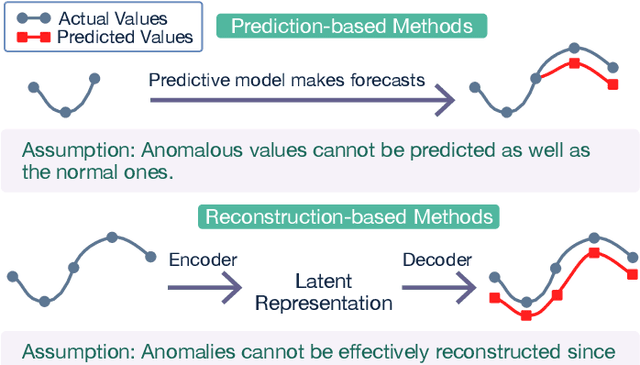
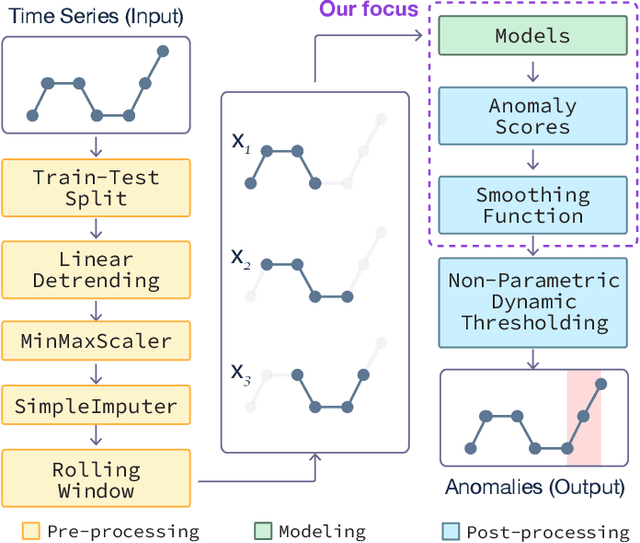
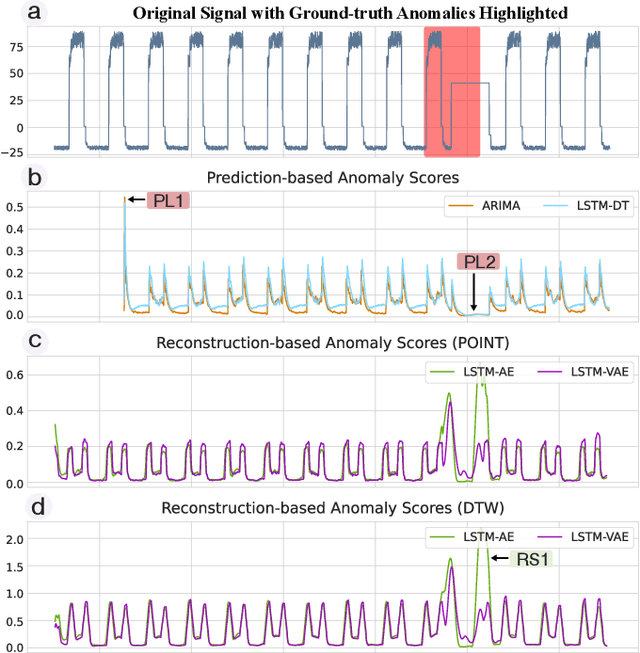
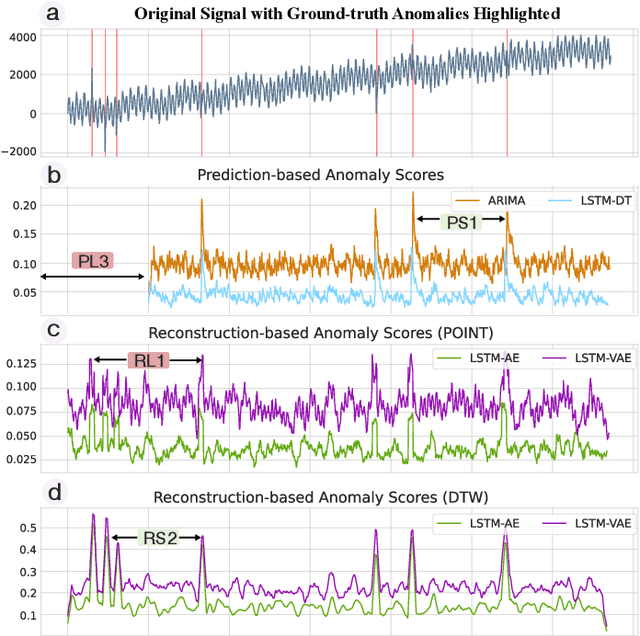
Abstract:Anomaly detection on time series data is increasingly common across various industrial domains that monitor metrics in order to prevent potential accidents and economic losses. However, a scarcity of labeled data and ambiguous definitions of anomalies can complicate these efforts. Recent unsupervised machine learning methods have made remarkable progress in tackling this problem using either single-timestamp predictions or time series reconstructions. While traditionally considered separately, these methods are not mutually exclusive and can offer complementary perspectives on anomaly detection. This paper first highlights the successes and limitations of prediction-based and reconstruction-based methods with visualized time series signals and anomaly scores. We then propose AER (Auto-encoder with Regression), a joint model that combines a vanilla auto-encoder and an LSTM regressor to incorporate the successes and address the limitations of each method. Our model can produce bi-directional predictions while simultaneously reconstructing the original time series by optimizing a joint objective function. Furthermore, we propose several ways of combining the prediction and reconstruction errors through a series of ablation studies. Finally, we compare the performance of the AER architecture against two prediction-based methods and three reconstruction-based methods on 12 well-known univariate time series datasets from NASA, Yahoo, Numenta, and UCR. The results show that AER has the highest averaged F1 score across all datasets (a 23.5% improvement compared to ARIMA) while retaining a runtime similar to its vanilla auto-encoder and regressor components. Our model is available in Orion, an open-source benchmarking tool for time series anomaly detection.
Sintel: A Machine Learning Framework to Extract Insights from Signals
Apr 19, 2022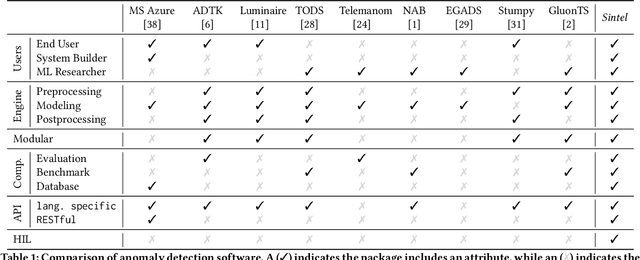
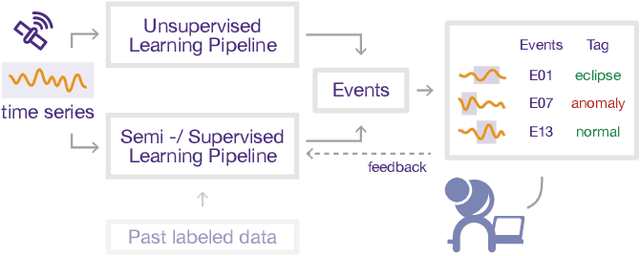
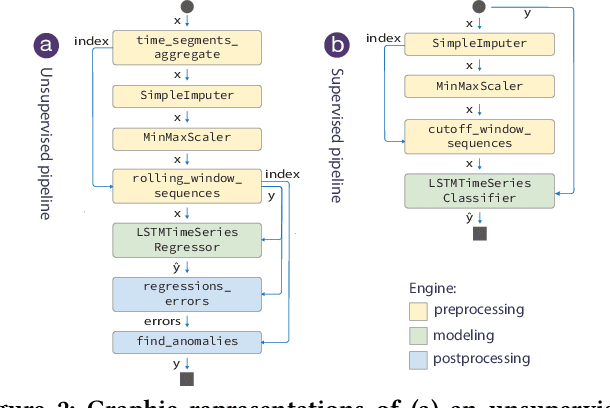

Abstract:The detection of anomalies in time series data is a critical task with many monitoring applications. Existing systems often fail to encompass an end-to-end detection process, to facilitate comparative analysis of various anomaly detection methods, or to incorporate human knowledge to refine output. This precludes current methods from being used in real-world settings by practitioners who are not ML experts. In this paper, we introduce Sintel, a machine learning framework for end-to-end time series tasks such as anomaly detection. The framework uses state-of-the-art approaches to support all steps of the anomaly detection process. Sintel logs the entire anomaly detection journey, providing detailed documentation of anomalies over time. It enables users to analyze signals, compare methods, and investigate anomalies through an interactive visualization tool, where they can annotate, modify, create, and remove events. Using these annotations, the framework leverages human knowledge to improve the anomaly detection pipeline. We demonstrate the usability, efficiency, and effectiveness of Sintel through a series of experiments on three public time series datasets, as well as one real-world use case involving spacecraft experts tasked with anomaly analysis tasks. Sintel's framework, code, and datasets are open-sourced at https://github.com/sintel-dev/.
The Need for Interpretable Features: Motivation and Taxonomy
Feb 23, 2022



Abstract:Through extensive experience developing and explaining machine learning (ML) applications for real-world domains, we have learned that ML models are only as interpretable as their features. Even simple, highly interpretable model types such as regression models can be difficult or impossible to understand if they use uninterpretable features. Different users, especially those using ML models for decision-making in their domains, may require different levels and types of feature interpretability. Furthermore, based on our experiences, we claim that the term "interpretable feature" is not specific nor detailed enough to capture the full extent to which features impact the usefulness of ML explanations. In this paper, we motivate and discuss three key lessons: 1) more attention should be given to what we refer to as the interpretable feature space, or the state of features that are useful to domain experts taking real-world actions, 2) a formal taxonomy is needed of the feature properties that may be required by these domain experts (we propose a partial taxonomy in this paper), and 3) transforms that take data from the model-ready state to an interpretable form are just as essential as traditional ML transforms that prepare features for the model.
VBridge: Connecting the Dots Between Features, Explanations, and Data for Healthcare Models
Aug 04, 2021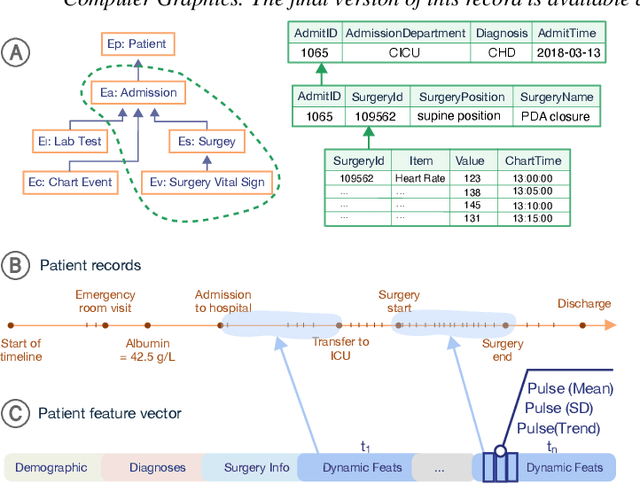
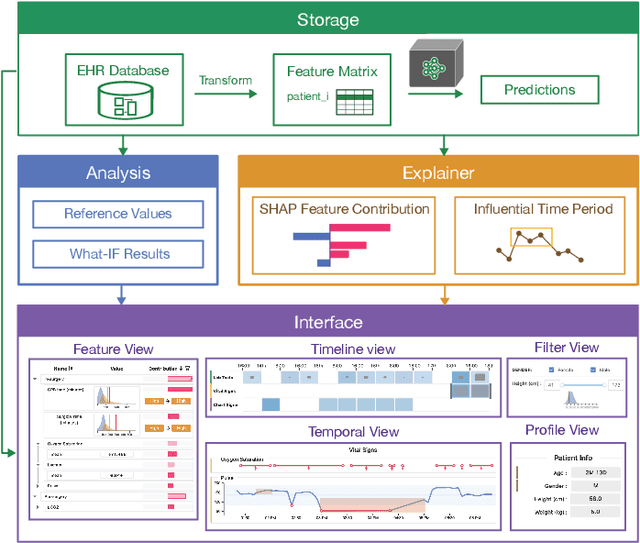
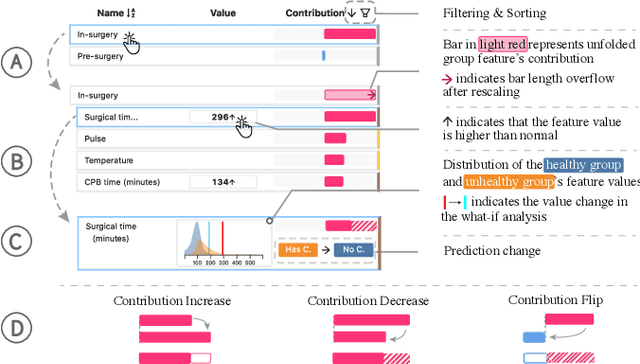
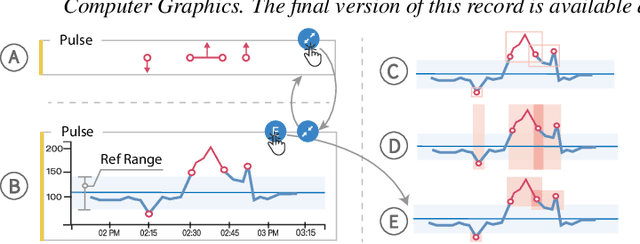
Abstract:Machine learning (ML) is increasingly applied to Electronic Health Records (EHRs) to solve clinical prediction tasks. Although many ML models perform promisingly, issues with model transparency and interpretability limit their adoption in clinical practice. Directly using existing explainable ML techniques in clinical settings can be challenging. Through literature surveys and collaborations with six clinicians with an average of 17 years of clinical experience, we identified three key challenges, including clinicians' unfamiliarity with ML features, lack of contextual information, and the need for cohort-level evidence. Following an iterative design process, we further designed and developed VBridge, a visual analytics tool that seamlessly incorporates ML explanations into clinicians' decision-making workflow. The system includes a novel hierarchical display of contribution-based feature explanations and enriched interactions that connect the dots between ML features, explanations, and data. We demonstrated the effectiveness of VBridge through two case studies and expert interviews with four clinicians, showing that visually associating model explanations with patients' situational records can help clinicians better interpret and use model predictions when making clinician decisions. We further derived a list of design implications for developing future explainable ML tools to support clinical decision-making.
 Add to Chrome
Add to Chrome Add to Firefox
Add to Firefox Add to Edge
Add to Edge